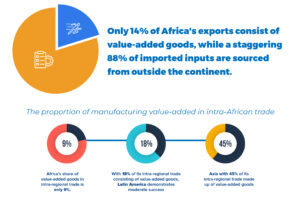Regional and global value chains offer Africa a path to economic growth through strategic integration and value addition, a new report suggests. With vast resources and emerging industries, Africa could become a global powerhouse.
By Bonface Orucho
Africa holds untapped potential in global and regional value chains, with the capacity to redefine its economic trajectory through strategic investments and integration, according to a new report.
The report, Regional Value Chains and Intra-African Trade Promotion, jointly by the Afreximbank and the University of Development Studies, Ghana, highlights that by tapping into opportunities in sectors such as agriculture, manufacturing, and technology, Africa can transition from being a primary exporter to a prominent player in value-added global trade.
“Africa could leverage a number of products and services across various sectors to develop and enhance Regional Value Chains (RVCs)… Effective RVC participation creates the requisite platform as a launching pad for ease of entry of African economies into Global Value Chains (GVCs),” the authors outline in the report.
The UN Trade and Development defines Regional Value Chains (RVCs)—a localised form of a global value chain (GVC)—as a form of trade that involves a chain of intermediate products and services value addition from multiple contributing countries into a final product.
Paul Mundia, the executive director of the Continental Leadership Institute—a South Zambia-based organisation dedicated to sustainable development, human rights, governance, policy, trade, and more—emphasises that Africa’s abundant natural resources, vibrant youthful population, and strategic geographical positioning present unparalleled opportunities to strengthen trade and connectivity across the continent.
“These factors—resources, a youthful population, a growing market, and strategic positioning—are vital for driving sustainable development and inclusive economic growth. However, tapping into these advantages requires focused and coordinated efforts,” he explained in an interview with Bird Story Agency.
According to the report, potential regional value chains in Africa vary across different locations. In Central Africa, these include coltan, wood, and copper. East Africa can focus on coffee, tourism, and floriculture, while North Africa can emphasise date palm, energy production, and phosphate. In West Africa, construction, poultry, and cashew nuts dominate, whereas Southern Africa’s key value chains include textiles, edible salt, and aquaculture.
Jeremiah Rogito, an agribusiness specialist with AGRA, emphasised that Africa’s large population and vast land resources provide a strong foundation for developing globally competitive value chains, especially in agriculture. The specialist with the organisations formerly known as the Alliance for Green Revolution argued that these factors make agriculture a dominant sector that offers immense potential for value-added economic growth.
“We have a large population that provides the labour needed for sustainable productivity. Second, approximately 60% of the continent’s arable land is still unutilized. This presents immense potential for sustainable agricultural production,” he explained in a call with Bird Story Agency.
“Industries related to agricultural input supply, such as seed production, fertilisers, and chemicals, are high potential value chain development areas. These inputs are foundational for increasing agricultural productivity and are in demand globally,” he added.
Beyond agriculture, Africa boasts an abundant supply of raw materials with utility in diverse sectors, such as in the energy, automotive and electronics sectors.
However, according to Afreximbank, African economies have not taken advantage of these raw materials to create value-added products compared to other regions, such as Latin America and Asia.
“The proportion of manufacturing value-added in intra-African trade is a mere 9% compared to 18% and 45% in Latin America and Asia, respectively… other continents participate more strongly in GVC than Africa,” Afrexim explains in the report.
Only 14% of Africa’s exports consist of value-added goods, while a staggering 88% of imported inputs are sourced from outside the continent, according to the report.

According to Mundia, the limited integration into global and regional value chains is hindered by challenges such as inadequate infrastructure, a limited entrepreneurial base, trade barriers, and weak institutional frameworks.
Beyond agriculture, other high-potential industries can be leveraged when building Africa’s participation in global value chains, such as the leather industry. According to Afreximbank, leather’s forward and backward linkages across various sectors continue to favour its market.
“There is an increasing demand for leather products both within the continent and without, which presents the region with a needed market to tap into… The market demand is comparable to products like coffee and rice,” the authors noted in the report.
The automotive industry is another high-potential sector with experts arguing for its ability to boost the economic trajectory of some countries on the continent.
Notably, Africa’s automotive industry value’s market is estimated at US$30.44 billion, with projections to reach more than US$42 billion by 2027, according to the Afdb. South Africa and Morocco are noted to control about 81% of the export market.
Africa’s automotive industry is driven by key hubs like Nigeria, Morocco, Kenya, and South Africa, supported by regional contributors. In the West, countries like Ivory Coast and Benin play vital roles, while North Africa is led by Libya, Algeria, Egypt, and Tunisia.
East Africa includes Tanzania and Rwanda, and Southern Africa is bolstered by nations like Mozambique, Namibia, and Zambia. Together, these regions create a solid foundation for a competitive industry value chain.
“Some progress has been made in forming the African Association of Automative Manufacturers… With support from the South African government, the association seeks to develop subregional hubs to drive the industry’s development on the continent,” the report explains.
bird story agency
A new report suggests that Africa has significant potential to enhance economic growth by integrating into regional and global value chains (RVCs and GVCs). With abundant natural resources and a vibrant youthful population, Africa can strategically invest in sectors like agriculture, manufacturing, and technology to transition from primarily exporting raw materials to producing value-added goods. The report highlights opportunities across various regions, such as coltan in Central Africa, coffee in East Africa, and textiles in Southern Africa. However, Africa currently lags in manufacturing value-added products compared to regions like Latin America and Asia.
Challenges such as inadequate infrastructure and weak institutional frameworks hinder Africa's integration into these value chains. Nonetheless, high-potential industries, including the automotive and leather sectors, offer promising prospects for development. Africa's automotive industry, led by key players like South Africa and Morocco, shows significant market potential with projections to grow to over $42 billion by 2027. Strategic efforts and regional collaboration, as evidenced by initiatives like the African Association of Automotive Manufacturers, are critical to advancing industrial growth on the continent.






